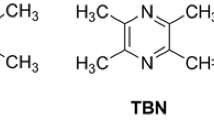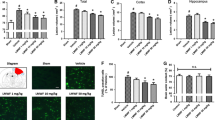Abstract
Progressive age-associated increases in cerebral dysfunction have been shown to occur following traumatic brain injury (TBI). Moreover, levels of neuronal mitochondrial antioxidant enzymes in the aged brain are reduced, resulting in free radical-induced cell death. It was hypothesized that cognitive impairment after TBI in the aged progresses to a greater degree than in younger individuals, and that damage involves neuronal degeneration and death by free radicals. In this study, we investigated the effects of free radicals on neuronal degeneration, cell death, and cognitive impairment in 10-week-old (young group) and 24-month-old rats (aged group) subjected to TBI. Young and aged rats received TBI with a pneumatic controlled injury device. At 1, 3 and 7 days after TBI, immunohistochemistry, lipid peroxidation and behavioral studies were performed. At 1, 3 and 7 days post-TBI, the number of 8-hydroxy-2′-deoxyguanosine-, 4-hydroxy-2-nonenal- and single-stranded DNA (ssDNA)-positive cells, and the levels of malondialdehyde around the damaged area after TBI significantly increased in the aged group when compared with the young group (P < 0.05). In addition, the majority of ssDNA-positive cells in both groups co-localized with neuronal cells around the damaged area. There was a significant decrease in the number of surviving neurons and an increase in cognitive impairment after TBI in the aged group when compared with the young group (P < 0.05). These results indicate that following TBI, high levels of free radicals are produced in the aged rat brain, which induces neuronal degeneration and apoptotic cell death around the damaged area, resulting in cognitive impairment.








Similar content being viewed by others
References
Ates O, Cayli S, Altinoz E, Gurses I, Yucel N, Sener M, Kocak A, Yologlu S (2007) Neuroprotection by resveratrol against traumatic brain injury in rats. Mol Cell Biochem 294(1–2):137–144
Azbill RD, Mu X, Bruce-Keller AJ, Mattson MP, Springer JE (1997) Impaired mitochondrial function, oxidative stress and altered antioxidant enzyme activities following traumatic spinal cord injury. Brain Res 765(2):283–290
Buga AM, Dunoiu C, Balseanu A, Popa-Wagner A (2008) Cellular and molecular mechanisms underlying neurorehabilitation after stroke in aged subjects. Rom J Morphol Embryol 49(3):279–302
Chan PH, Fishman RA, Longar S, Chen S, Yu A (1985) Cellular and molecular effects of polyunsaturated fatty acids in brain ischemia and injury. Prog Brain Res 63:227-235
Clausen F, Lundqvist H, Ekmark S, Lewen A, Ebendal T, Hillered L (2004) Oxygen free radical-dependent activation of extracellular signal-regulated kinase mediates apoptosis-like cell death after traumatic brain injury. J Neurotrauma 21(9):1168–1182
Das S, Mandal AK, Ghosh A, Panda S, Das N, Sarkar S (2008) Nanoparticulated quercetin in combating age related cerebral oxidative injury. Curr Aging Sci 1(3):169–174
Dorszewska J, Adamczewska-Goncerzewicz Z, Szczech J (2004) Apoptotic proteins in the course of aging of central nervous system in the rat. Respir Physiol Neurobiol 139(2):145–155
Gilmer LK, Ansari MA, Roberts KN, Scheff SW (2010) Age-related changes in mitochondrial respiration and oxidative damage in the cerebral cortex of the Fischer 344 rat. Mech Ageing Dev 131(2):133–143
Hall ED, Braughler JM (1989) Central nervous system trauma and stroke. II. Physiological and pharmacological evidence for involvement of oxygen radicals and lipid peroxidation. Free Radic Biol Med 6(3):303–313
Hamm RJ, Jenkins LW, Lyeth BG, White-Gbadebo DM, Hayes RL (1991) The effect of age on outcome following traumatic brain injury in rats. J Neurosurg 75(6):916–921
Hata R, Gillardon F, Michaelidis TM, Hossmann KA (1999) Targeted disruption of the bcl-2 gene in mice exacerbates focal ischemic brain injury. Metab Brain Dis 14(2):117–124
Hockenbery D, Nunez G, Milliman C, Schreiber RD, Korsmeyer SJ (1990) Bcl-2 is an inner mitochondrial membrane protein that blocks programmed cell death. Nature 348(6299):334–336
Irving EA, Bamford M (2002) Role of mitogen- and stress-activated kinases in ischemic injury. J Cereb Blood Flow Metab 22(6):631–647
Itoh T, Satou T, Hashimoto S, Ito H (2005) Isolation of neural stem cells from damaged rat cerebral cortex after TBI. Neuroreport 16(15):1687–1691
Itoh T, Satou T, Hashimoto S, Ito H (2007) Immature and mature neurons coexist among glial scars after rat traumatic brain injury. Neurol Res 29(7):734–742
Itoh T, Satou T, Nishida S, Tsubaki M, Hashimoto S, Ito H (2009a) Expression of amyloid precursor protein after rat traumatic brain injury. Neurol Res 31(1):103–109
Itoh T, Satou T, Nishida S, Tsubaki M, Hashimoto S, Ito H (2009b) Improvement of cerebral function by anti-amyloid precursor protein antibody infusion after traumatic brain injury in rats. Mol Cell Biochem 324(1–2):191–199
Itoh T, Satou T, Nishida S, Tsubaki M, Imano M, Hashimoto S, Ito H (2010) Edaravone protects against apoptotic neuronal cell death and improves cerebral function after traumatic brain injury in rats. Neurochem Res 35(2):348–355
Itoh T, Imano M, Nishida S, Tsubaki M, Hashimoto S, Ito A, Satou T (2011) Exercise inhibits neuronal apoptosis and improves cerebral function following rat traumatic brain injury. J Neural Transm 118(9):1263–1272
Jin Y, Yan EZ, Li XM, Fan Y, Zhao YJ, Liu Z, Liu WZ (2008) Neuroprotective effect of sodium ferulate and signal transduction mechanisms in the aged rat hippocampus. Acta Pharmacol Sin 29(12):1399–1408
Kawamata T, Katayama Y, Hovda DA, Yoshino A, Becker DP (1995) Lactate accumulation following concussive brain injury: the role of ionic fluxes induced by excitatory amino acids. Brain Res 674(2):196–204
Kontos HA, George E (1985) Brown memorial lecture. Oxygen radicals in cerebral vascular injury. Circ Res 57(4):508–516
Lee EJ, Lee MY, Chen HY, Hsu YS, Wu TS, Chen ST, Chang GL (2005) Melatonin attenuates gray and white matter damage in a mouse model of transient focal cerebral ischemia. J Pineal Res 38(1):42–52
Luerssen TG, Klauber MR, Marshall LF (1988) Outcome from head injury related to patient’s age. A longitudinal prospective study of adult and pediatric head injury. J Neurosurg 68(3):409–416
Lynch AM, Lynch MA (2002) The age-related increase in IL-1 type I receptor in rat hippocampus is coupled with an increase in caspase-3 activation. Eur J Neurosci 15(11):1779–1788
Martinez-Lara E, Canuelo AR, Siles E, Hernandez R, Del Moral ML, Blanco S, Pedrosa JA, Rodrigo J, Peinado MA (2005) Constitutive nitric oxide synthases are responsible for the nitric oxide production in the ischemic aged cerebral cortex. Brain Res 1054(1):88–94
Martinou JC, Dubois-Dauphin M, Staple JK, Rodriguez I, Frankowski H, Missotten M, Albertini P, Talabot D, Catsicas S, Pietra C et al (1994) Overexpression of BCL-2 in transgenic mice protects neurons from naturally occurring cell death and experimental ischemia. Neuron 13(4):1017–1030
Ochoa JJ, Pamplona R, Ramirez-Tortosa MC, Granados-Principal S, Perez-Lopez P, Naudi A, Portero-Otin M, Lopez-Frias M, Battino M, Quiles JL (2011) Age-related changes in brain mitochondrial DNA deletion and oxidative stress are differentially modulated by dietary fat type and coenzyme Q. Free Radic Biol Med 50(9):1053–1064
Pentland B, Jones PA, Roy CW, Miller JD (1986) Head injury in the elderly. Age Ageing 15(4):193–202
Sauerbeck A, Gao J, Readnower R, Liu M, Pauly JR, Bing G, Sullivan PG (2011) Pioglitazone attenuates mitochondrial dysfunction, cognitive impairment, cortical tissue loss, and inflammation following traumatic brain injury. Exp Neurol 227(1):128–135
Shultz SR, Bao F, Omana V, Chiu C, Brown A, Cain DP (2011) Repeated mild lateral fluid percussion brain injury in the rat causes cumulative long-term behavioral impairments, neuroinflammation, and cortical loss in an animal model of repeated concussion. J Neurotrauma. doi:10.1089/neu.2011.2123
Smith DR, Hoyt EC, Gallagher M, Schwabe RF, Lund PK (2001) Effect of age and cognitive status on basal level AP-1 activity in rat hippocampus. Neurobiol Aging 22(5):773–786
Sugawara T, Noshita N, Lewen A, Gasche Y, Ferrand-Drake M, Fujimura M, Morita-Fujimura Y, Chan PH (2002) Overexpression of copper/zinc superoxide dismutase in transgenic rats protects vulnerable neurons against ischemic damage by blocking the mitochondrial pathway of caspase activation. J Neurosci 22(1):209–217
Tsuji M, Inanami O, Kuwabara M (2000) Neuroprotective effect of alpha-phenyl-N-tert-butylnitrone in gerbil hippocampus is mediated by the mitogen-activated protein kinase pathway and heat shock proteins. Neurosci Lett 282(1–2):41–44
Wasserman JK, Schlichter LC (2008) White matter injury in young and aged rats after intracerebral hemorrhage. Exp Neurol 214(2):266–275
Werner C, Engelhard K (2007) Pathophysiology of traumatic brain injury. Br J Anaesth 99(1):4–9
Wilson JA, Pentland B, Currie CT, Miller JD (1987) The functional effects of head injury in the elderly. Brain Inj 1(2):183–188
Xiong Y, Gu Q, Peterson PL, Muizelaar JP, Lee CP (1997) Mitochondrial dysfunction and calcium perturbation induced by traumatic brain injury. J Neurotrauma 14(1):23–34
Xiong Y, Mahmood A, Lu D, Qu C, Kazmi H, Goussev A, Zhang ZG, Noguchi CT, Schallert T, Chopp M (2008) Histological and functional outcomes after traumatic brain injury in mice null for the erythropoietin receptor in the central nervous system. Brain Res 1230:247–257
Xu K, Puchowicz MA, Sun X, LaManna JC (2008) Mitochondrial dysfunction in aging rat brain following transient global ischemia. Adv Exp Med Biol 614:379–386
Acknowledgments
The authors thank Mari Yachi for technical assistance.
Conflict of interest
The authors have no conflicts of interest to declare.
Author information
Authors and Affiliations
Corresponding author
Rights and permissions
About this article
Cite this article
Itoh, T., Imano, M., Nishida, S. et al. Increased apoptotic neuronal cell death and cognitive impairment at early phase after traumatic brain injury in aged rats. Brain Struct Funct 218, 209–220 (2013). https://doi.org/10.1007/s00429-012-0394-5
Received:
Accepted:
Published:
Issue Date:
DOI: https://doi.org/10.1007/s00429-012-0394-5




